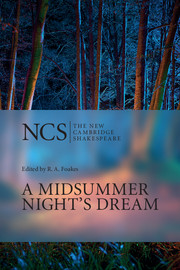Book contents
- The New Cambridge Shakespeare
- The New Cambridge Shakespeare
- A Midsummer Night's Dream
- Copyright page
- The New Cambridge Shakespeare
- Contents
- Illustrations
- Preface
- Abbreviations and conventions
- Introduction
- Note on the Text
- A Midsummer Night’s Dream
- Textual Analysis
- Appendix: A Further Note on Sources
- Reading List
- References
Reading List
Published online by Cambridge University Press: 02 August 2019
- The New Cambridge Shakespeare
- The New Cambridge Shakespeare
- A Midsummer Night's Dream
- Copyright page
- The New Cambridge Shakespeare
- Contents
- Illustrations
- Preface
- Abbreviations and conventions
- Introduction
- Note on the Text
- A Midsummer Night’s Dream
- Textual Analysis
- Appendix: A Further Note on Sources
- Reading List
- References
- Type
- Chapter
- Information
- A Midsummer Night's Dream , pp. 154 - 156Publisher: Cambridge University PressPrint publication year: 2003



